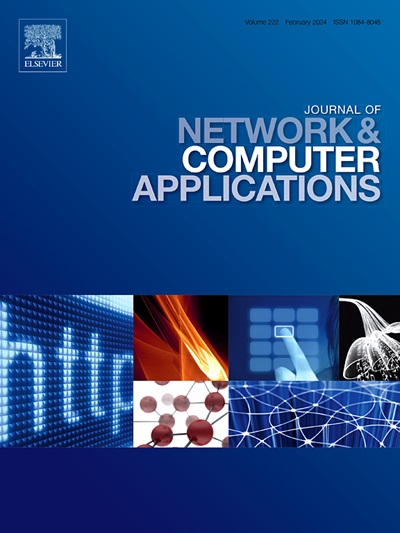Addressing security requirements in industrial IoT: A robust three-factor authentication scheme with enhanced features
IF 7.7
2区 计算机科学
Q1 COMPUTER SCIENCE, HARDWARE & ARCHITECTURE
引用次数: 0
Abstract
Authentication and Key Agreement (AKA) is a critical component for ensuring access control for legitimate users in the Industrial Internet of Things (IIoT). Traditional three-factor AKA schemes rely on the user’s password, biometric data, and smart card to provide robust security. However, existing schemes often suffer from vulnerabilities, such as password guessing attacks, which can occur if either the biometric data or the smart card is compromised. Additionally, several crucial security requirements, including Perfect Forward Secrecy (PFS), user anonymity, un-traceability, and resistance to Ephemeral Secret Leakage (ESL) and node capture attacks, have remained unaddressed in prior approaches. This paper presents a comprehensive solution to these challenges by proposing an improved three-factor AKA scheme for IIoT. The scheme effectively integrates the three factors—biometric data, smart card, and password—to achieve three-factor security. These three factors include: (1) Biometric Data: The scheme uses fuzzy extractors to handle the inherent noise in biometric data while extracting consistent cryptographic keys. This ensures that even if the biometric template is compromised, the extracted key remains secure. (2) Smart Card: The smart card stores a securely hashed version of the user’s credentials and a unique identifier. It employs modular arithmetic on hash functions (e.g., SHA-256) to generate and manage session keys, ensuring lightweight yet robust security. (3) Password: The user’s password is combined with the biometric key and smart card data through a one-way hash function and modular arithmetic operations. This creates a multi-layered authentication mechanism that prevents password guessing attacks even if one factor is compromised. To address the critical security requirements, the proposed scheme employs the following techniques to realize a robust security: (i) Perfect Forward Secrecy (PFS): PFS is achieved using Elliptic Curve Diffie–Hellman (ECDH) key exchange over elliptic curves. Each session generates a unique ephemeral key pair, ensuring that even if long-term keys are compromised, past sessions remain secure. (ii) Resistance to Ephemeral Secret Leakage (ESL): The scheme incorporates key derivation functions (KDFs) and salted hashes to ensure that ephemeral secrets cannot be exploited even if leaked during a session. (iii) Resistance to Node Capture Attacks: To defend against node capture attacks, the scheme uses two sets of pseudo-identities and distributed secret sharing. The main pseudo-identity and secret key of the user are never stored in the sensor, ensuring that capturing a sensor node does not compromise the user’s credentials or the overall system. The security of the proposed scheme is rigorously analyzed using formal verification methods, including BAN logic and ProVerif, to demonstrate its resilience against known attack vectors. Experimental results show that the scheme achieves strong computational performance and minimizes communication overhead compared to existing alternatives. Furthermore, simulations on the NS-3 platform confirm its practical feasibility for IIoT environments.
解决工业物联网中的安全需求:具有增强功能的强大三因素身份验证方案
身份验证和密钥协议(AKA)是确保工业物联网(IIoT)中合法用户访问控制的关键组件。传统的三因素AKA方案依赖于用户的密码、生物特征数据和智能卡来提供强大的安全性。然而,现有的方案往往存在漏洞,例如密码猜测攻击,如果生物特征数据或智能卡被泄露,就可能发生这种攻击。此外,几个关键的安全需求,包括完美前向保密(PFS)、用户匿名性、不可追溯性、抗短暂秘密泄漏(ESL)和节点捕获攻击,在以前的方法中仍然没有得到解决。本文通过提出一种改进的工业物联网三因素AKA方案,为这些挑战提供了一个全面的解决方案。该方案有效集成了生物特征数据、智能卡、密码三要素,实现三要素安全。这三个因素包括:(1)生物特征数据:该方案使用模糊提取器处理生物特征数据中的固有噪声,同时提取一致的密码密钥。这确保了即使生物识别模板被泄露,提取的密钥仍然是安全的。(2)智能卡:智能卡存储用户凭据的安全散列版本和唯一标识符。它在哈希函数(例如SHA-256)上采用模块化算法来生成和管理会话密钥,确保轻量级但强大的安全性。(3)密码:通过单向哈希函数和模块化算术运算,将用户密码与生物识别密钥和智能卡数据组合在一起。这创建了一个多层身份验证机制,即使一个因素被泄露,也可以防止密码猜测攻击。为了满足关键的安全要求,该方案采用了以下技术来实现鲁棒安全性:(i)完美前向保密(PFS): PFS是通过椭圆曲线上的椭圆曲线Diffie-Hellman (ECDH)密钥交换来实现的。每个会话生成一个唯一的临时密钥对,确保即使长期密钥被泄露,过去的会话仍然是安全的。(ii)抗短暂秘密泄露(ESL):该方案结合了密钥派生函数(kdf)和加盐哈希,以确保即使在会话期间泄露短暂秘密也不会被利用。(iii)抗节点捕获攻击:为了防御节点捕获攻击,方案使用了两套伪身份和分布式秘密共享。用户的主要伪身份和密钥永远不会存储在传感器中,从而确保捕获传感器节点不会危及用户的凭据或整个系统。使用正式验证方法(包括BAN逻辑和ProVerif)严格分析了所提出方案的安全性,以证明其对已知攻击向量的弹性。实验结果表明,与现有方案相比,该方案具有较强的计算性能和最小的通信开销。此外,NS-3平台上的仿真验证了其在工业物联网环境中的实际可行性。
本文章由计算机程序翻译,如有差异,请以英文原文为准。
求助全文
约1分钟内获得全文
求助全文
来源期刊

Journal of Network and Computer Applications
工程技术-计算机:跨学科应用
CiteScore
21.50
自引率
3.40%
发文量
142
审稿时长
37 days
期刊介绍:
The Journal of Network and Computer Applications welcomes research contributions, surveys, and notes in all areas relating to computer networks and applications thereof. Sample topics include new design techniques, interesting or novel applications, components or standards; computer networks with tools such as WWW; emerging standards for internet protocols; Wireless networks; Mobile Computing; emerging computing models such as cloud computing, grid computing; applications of networked systems for remote collaboration and telemedicine, etc. The journal is abstracted and indexed in Scopus, Engineering Index, Web of Science, Science Citation Index Expanded and INSPEC.
 求助内容:
求助内容: 应助结果提醒方式:
应助结果提醒方式:


